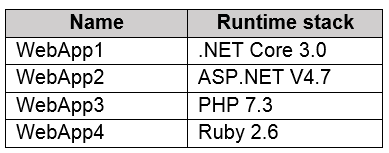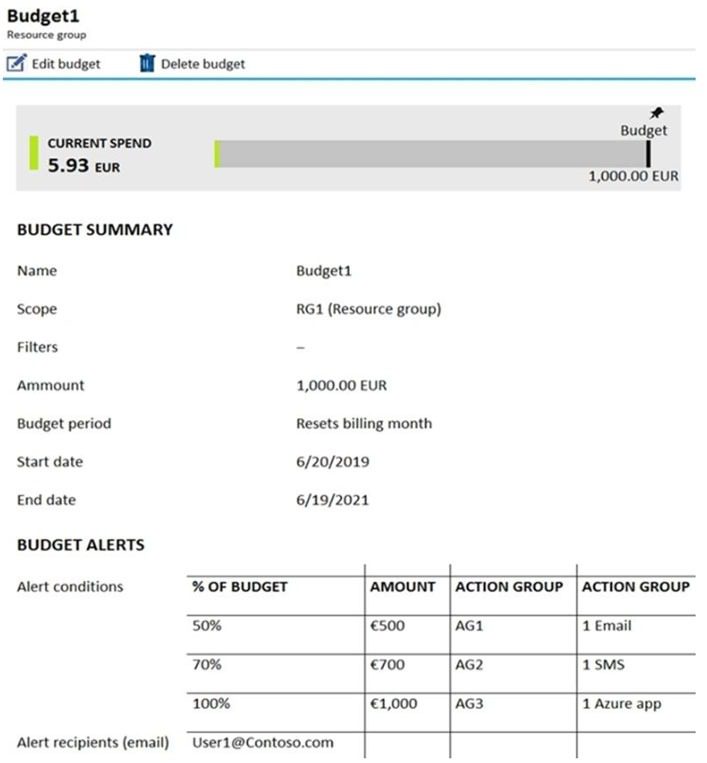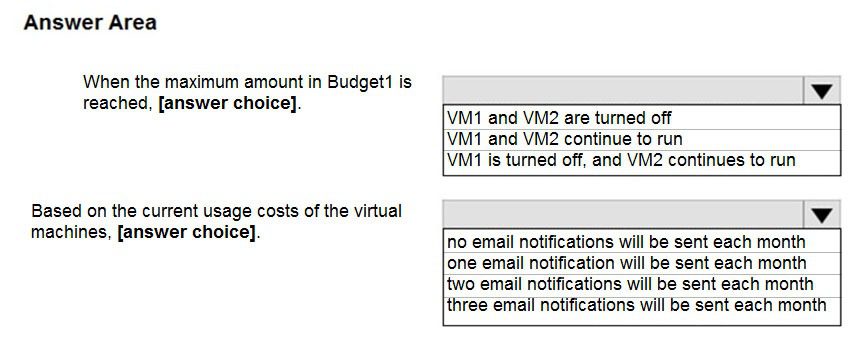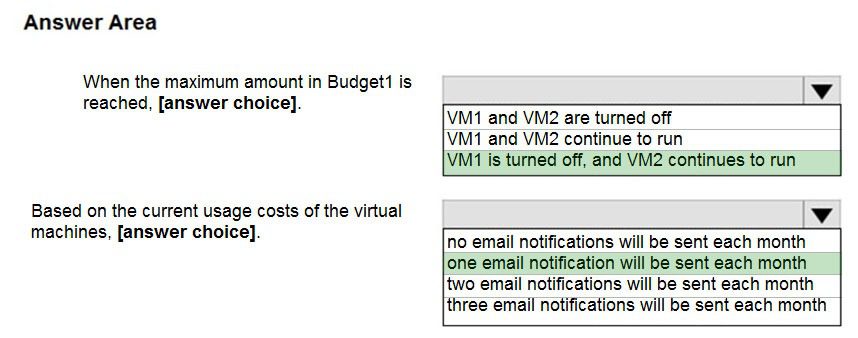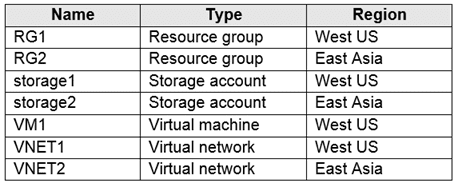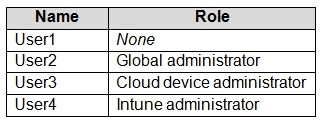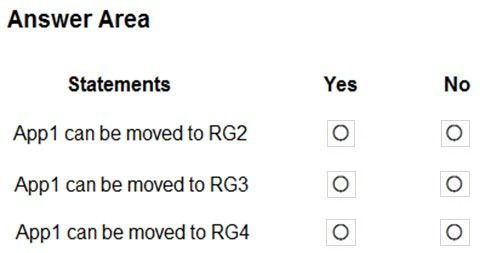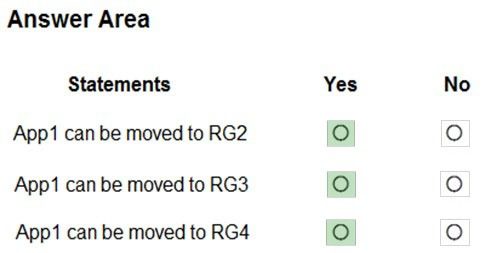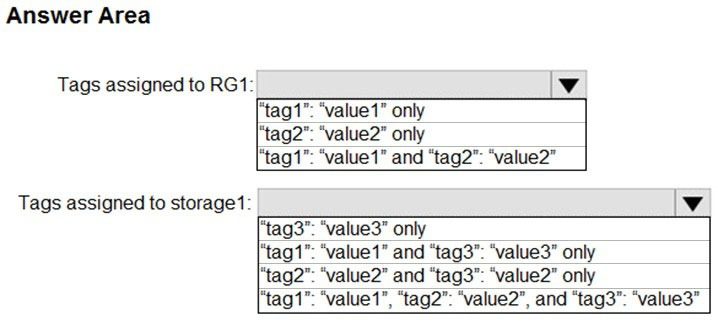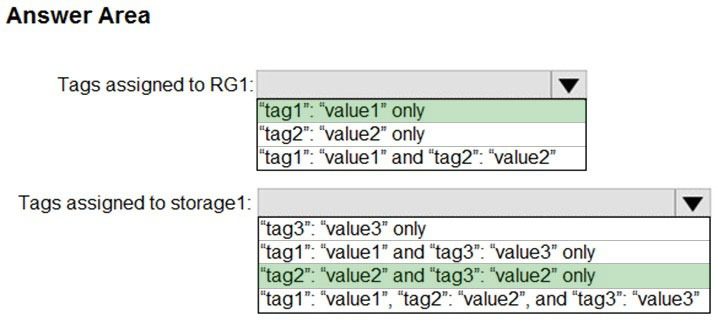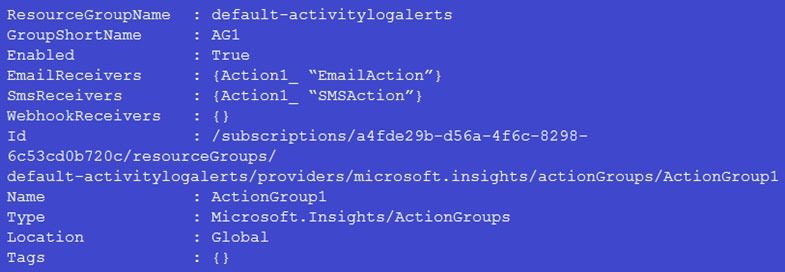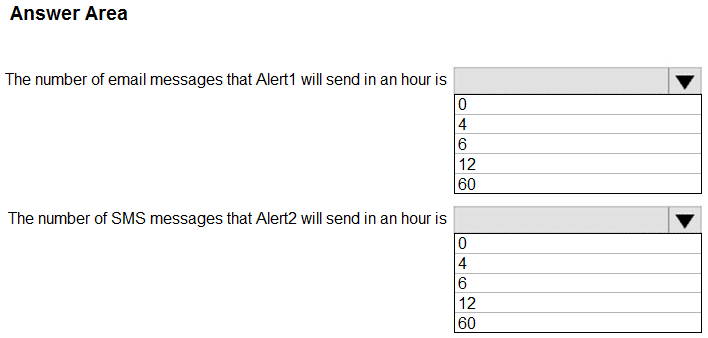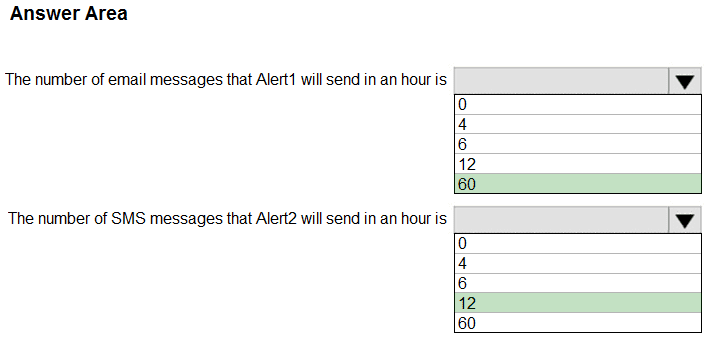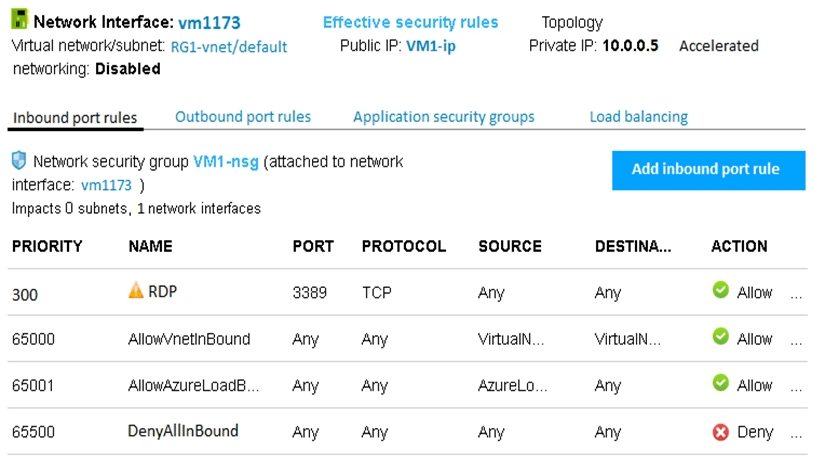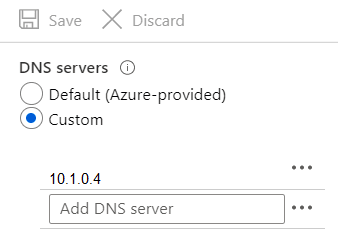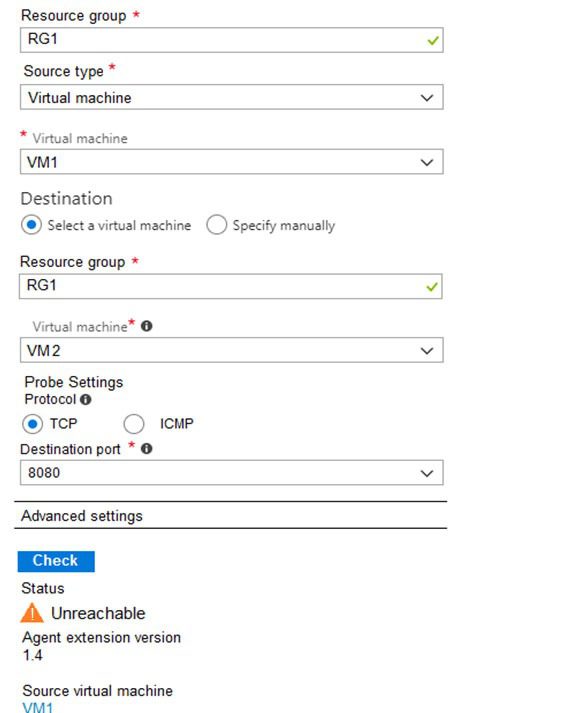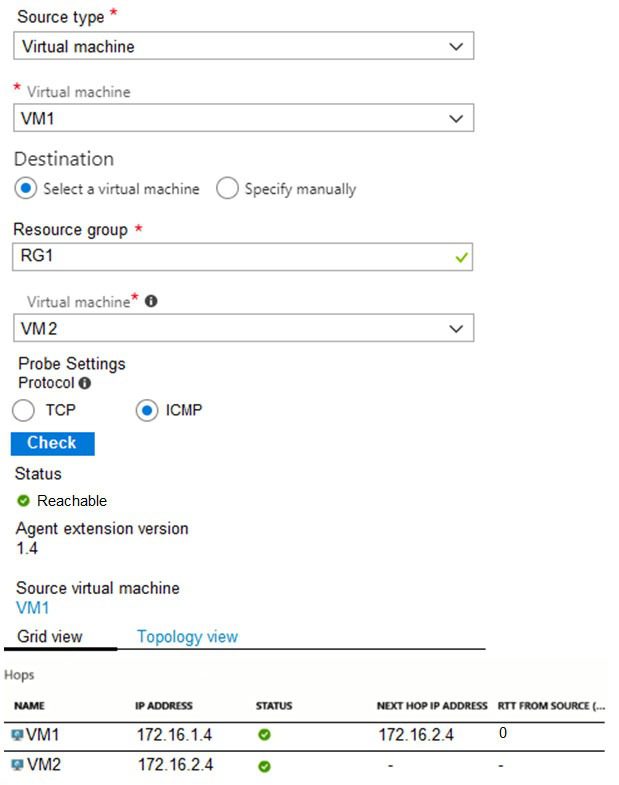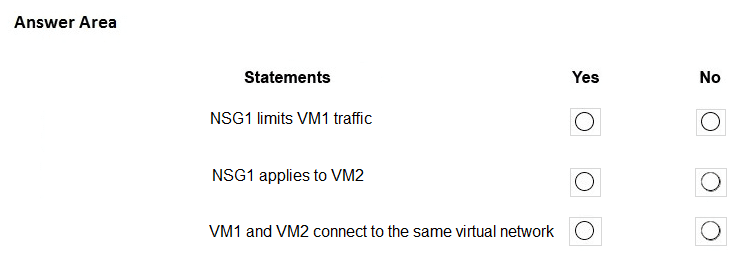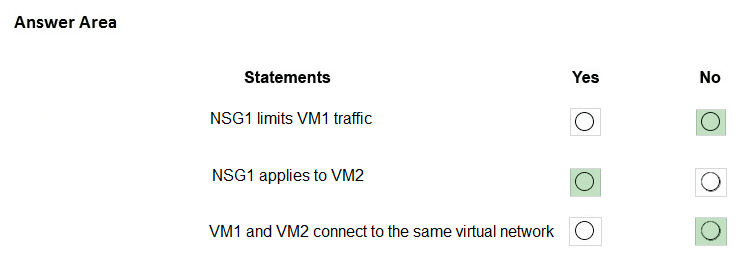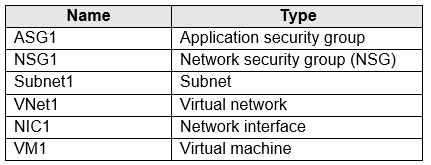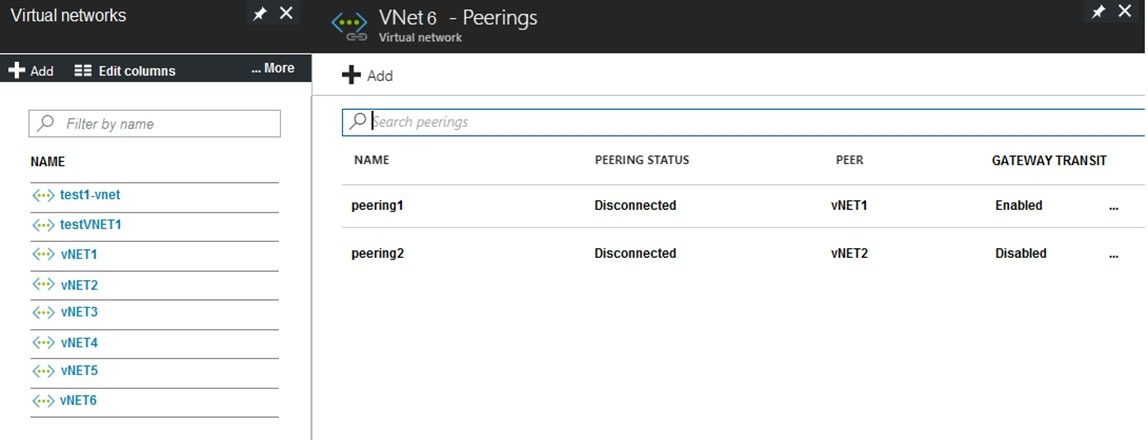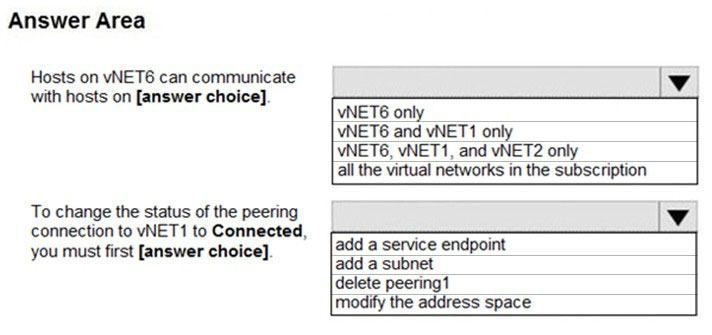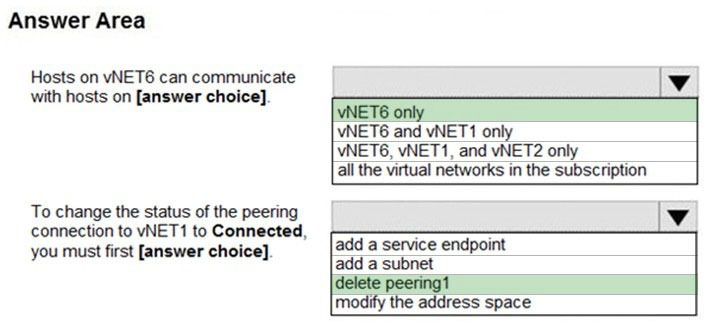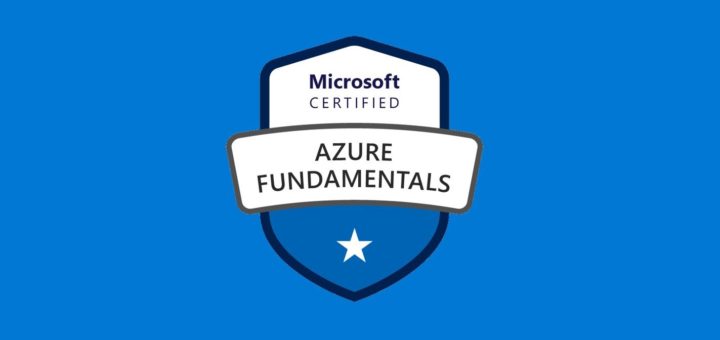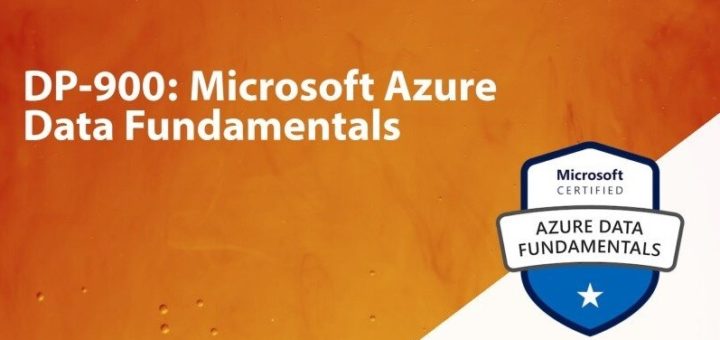Question #41
You have an app named App1 that runs on an Azure web app named webapp1.
The developers at your company upload an update of App1 to a Git repository named Git1.
Webapp1 has the deployment slots shown in the following table.
You need to ensure that the App1 update is tested before the update is made available to users.
Which two actions should you perform? Each correct answer presents part of the solution.
- A. Swap the slots
- B. Deploy the App1 update to webapp1-prod, and then test the update
- C. Stop webapp1-prod
- D. Deploy the App1 update to webapp1-test, and then test the update
- E. Stop webapp1-test
Correct Answer: AD
Question #42
You have an Azure subscription named Subscription1 that has the following providers registered:
✑ Authorization
✑ Automation
✑ Resources
✑ Compute
✑ KeyVault
✑ Network
✑ Storage
✑ Billing
✑ Web
Subscription1 contains an Azure virtual machine named VM1 that has the following configurations:
✑ Private IP address: 10.0.0.4 (dynamic)
✑ Network security group (NSG): NSG1
✑ Public IP address: None
✑ Availability set: AVSet
✑ Subnet: 10.0.0.0/24
✑ Managed disks: No
Location: East US –
You need to record all the successful and failed connection attempts to VM1.
Which three actions should you perform? Each correct answer presents part of the solution.
NOTE: Each correct selection is worth one point.
- A. Enable Azure Network Watcher in the East US Azure region.
- B. Add an Azure Network Watcher connection monitor.
- C. Register the MicrosoftLogAnalytics provider.
- D. Create an Azure Storage account.
- E. Register the Microsoft.Insights resource provider.
- F. Enable Azure Network Watcher flow logs.
Correct Answer: ACD
D: NSG flow log data is written to an Azure Storage account. You need to create an Azure Storage account,
With an Azure Storage account NSG flow logs can be enabled.
A: Enable network watcher in the East US region.
C: NSG flow logging requires the Microsoft.Insights provider.
Reference:
https://docs.microsoft.com/en-us/azure/network-watcher/network-watcher-nsg-flow-logging-portal
Question #43
You need to deploy an Azure virtual machine scale set that contains five instances as quickly as possible.
What should you do?
- A. Deploy five virtual machines. Modify the Availability Zones settings for each virtual machine.
- B. Deploy five virtual machines. Modify the Size setting for each virtual machine.
- C. Deploy one virtual machine scale set that is set to VM (virtual machines) orchestration mode.
- D. Deploy one virtual machine scale set that is set to ScaleSetVM orchestration mode.
Correct Answer: D
Reference:
https://docs.microsoft.com/en-us/azure/virtual-machine-scale-sets/orchestration-modes
Question #44
You plan to create the Azure web apps shown in the following table.
What is the minimum number of App Service plans you should create for the web apps?
- A. 1
- B. 2
- C. 3
- D. 4
Correct Answer: A
Question #45
HOTSPOT –
You have a pay-as-you-go Azure subscription that contains the virtual machines shown in the following table.
You create the budget shown in the following exhibit.
The AG1 action group contains a user named admin@contoso.com only.
Use the drop-down menus to select the answer choice that completes each statement based on the information presented in the graphic.
Hot Area:
Correct Answer:
Box 1: VM1 is turned off, and VM2 continues to run
The budget alerts are for Resource Group RG1, which include VM1, but not VM2.
Box 2: one email notification will be sent each month.
Budget alerts for Resource Group RG1, which include VM1, but not VM2.VM1 consumes 20 Euro/day. The 50%, 500 Euro limit, will be reached in 25 days, and an email will be sent.
The 70% and 100% alert conditions will not be reached within a month, and they don’t trigger email actions anyway.
Credit alerts: Credit alerts are generated automatically at 90% and at 100% of your Azure credit balance. Whenever an alert is generated, it’s reflected in cost alerts and in the email sent to the account owners. 90% and 100% will not be reached though.
Reference:
https://docs.microsoft.com/en-us/azure/cost-management-billing/costs/cost-mgt-alerts-monitor-usage-spending
Question #46
Note: This question is part of a series of questions that present the same scenario. Each question in the series contains a unique solution that might meet the stated goals. Some question sets might have more than one correct solution, while others might not have a correct solution.
After you answer a question in this section, you will NOT be able to return to it. As a result, these questions will not appear in the review screen.
You have an Azure subscription named Subscription1. Subscription1 contains a resource group named RG1. RG1 contains resources that were deployed by using templates.
You need to view the date and time when the resources were created in RG1.
Solution: From the Subscriptions blade, you select the subscription, and then click Programmatic deployment.
Does this meet the goal?
- A. Yes
- B. No
Correct Answer: B
From the RG1 blade, click Deployments. You see a history of deployment for the resource group.
Reference:
https://docs.microsoft.com/en-us/azure/azure-resource-manager/templates/template-tutorial-create-first-template?tabs=azure-powershell
Question #47
Note: This question is part of a series of questions that present the same scenario. Each question in the series contains a unique solution that might meet the stated goals. Some question sets might have more than one correct solution, while others might not have a correct solution.
After you answer a question in this section, you will NOT be able to return to it. As a result, these questions will not appear in the review screen.
You have an Azure subscription that contains the resources shown in the following table.
VM1 connects to VNET1.
You need to connect VM1 to VNET2.
Solution: You create a new network interface, and then you add the network interface to VM1.
Does this meet the goal?
- A. Yes
- B. No
Correct Answer: B
You should delete VM1. You recreate VM1, and then you add the network interface for VM1.
Note: When you create an Azure virtual machine (VM), you must create a virtual network (VNet) or use an existing VNet. You can change the subnet a VM is connected to after it’s created, but you cannot change the VNet.
Reference:
https://docs.microsoft.com/en-us/azure/virtual-machines/windows/network-overview
Question #48
You have an Azure Active Directory (Azure AD) tenant named adatum.com that contains the users shown in the following table.
Adatum.com has the following configurations:
✑ Users may join devices to Azure AD is set to User1.
✑ Additional local administrators on Azure AD joined devices is set to None.
You deploy Windows 10 to a computer named Computer1. User1 joins Computer1 to adatum.com.
You need to identify the local Administrator group membership on Computer1.
Which users are members of the local Administrators group?
- A. User1 only
- B. User2 only
- C. User1 and User2 only
- D. User1, User2, and User3 only
- E. User1, User2, User3, and User4
Correct Answer: C
Users may join devices to Azure AD – This setting enables you to select the users who can register their devices as Azure AD joined devices. The default is All.
Additional local administrators on Azure AD joined devices – You can select the users that are granted local administrator rights on a device. Users added here are added to the Device Administrators role in Azure AD. Global administrators, here User2, in Azure AD and device owners are granted local administrator rights by default.
Reference:
https://docs.microsoft.com/en-us/azure/active-directory/devices/device-management-azure-portal
Question #49
HOTSPOT –
You have Azure subscriptions named Subscription1 and Subscription2.
Subscription1 has following resource groups:
RG1 includes a web app named App1 in the West Europe location.
Subscription2 contains the following resource groups:
For each of the following statements, select Yes if the statement is true. Otherwise, select No.
NOTE: Each correct selection is worth one point.
Hot Area:
Correct Answer:
Reference:
https://docs.microsoft.com/en-us/azure/azure-resource-manager/management/move-limitations/app-service-move-limitations
Question #50
HOTSPOT –
You have an Azure subscription named Subscription1 that contains the following resource group:
✑ Name: RG1
✑ Region: West US
✑ Tag: “tag1”: “value1”
You assign an Azure policy named Policy1 to Subscription1 by using the following configurations:
✑ Exclusions: None
✑ Policy definition: Append a tag and its value to resources
✑ Assignment name: Policy1
✑ Parameters:
✑ Tag name: Tag2
✑ Tag value: Value2
After Policy1 is assigned, you create a storage account that has the following configuration:
✑ Name: storage1
✑ Location: West US
✑ Resource group: RG1
✑ Tags: “tag3”: “value3”
You need to identify which tags are assigned to each resource.
What should you identify? To answer, select the appropriate options in the answer area.
NOTE: Each correct selection is worth one point.
Hot Area:
Correct Answer:
Box 1: “tag1”: “value1” only –
Box 2: “tag2”: “value2” and “tag3”: “value2” only
Tags applied to the resource group are not inherited by the resources in that resource group.
Reference:
https://docs.microsoft.com/en-us/azure/azure-resource-manager/resource-group-using-tags
Question #51
HOTSPOT –
You have an Azure subscription named Subscription1.
In Subscription1, you create an alert rule named Alert1.
The Alert1 action group is configured as shown in the following exhibit.
Alert1 alert criteria triggered every minute.
Use the drop-down menus to select the answer choice that completes each statement based on the information presented in the graphic.
NOTE: Each correct selection is worth one point.
Hot Area:
Correct Answer:
Box 1: 60 –
One alert per minute will trigger one email per minute.
Box 2: 12 –
No more than 1 SMS every 5 minutes can be send, which equals 12 per hour.
Note: Rate limiting is a suspension of notifications that occurs when too many are sent to a particular phone number, email address or device. Rate limiting ensures that alerts are manageable and actionable.
The rate limit thresholds are:
✑ SMS: No more than 1 SMS every 5 minutes.
✑ Voice: No more than 1 Voice call every 5 minutes.
✑ Email: No more than 100 emails in an hour.
Other actions are not rate limited.
Reference:
https://docs.microsoft.com/en-us/azure/azure-monitor/platform/alerts-rate-limiting
Question #52
You have an Azure subscription named Subscription1 that contains the resources shown in the following table.
You create virtual machines in Subscription1 as shown in the following table.
You plan to use Vault1 for the backup of as many virtual machines as possible.
Which virtual machines can be backed up to Vault1?
- A. VM1 only
- B. VM3 and VMC only
- C. VM1, VM2, VM3, VMA, VMB, and VMC
- D. VM1, VM3, VMA, and VMC only
- E. VM1 and VM3 only
Correct Answer: D
To create a vault to protect virtual machines, the vault must be in the same region as the virtual machines. If you have virtual machines in several regions, create a
Recovery Services vault in each region.
Reference:
https://docs.microsoft.com/bs-cyrl-ba/azure/backup/backup-create-rs-vault
Question #53
You have an Azure Kubernetes Service (AKS) cluster named AKS1.
You need to configure cluster autoscaler for AKS1.
Which two tools should you use? Each correct answer presents a complete solution.
NOTE: Each correct selection is worth one point.
- A. the kubectl command
- B. the az aks command
- C. the Set-AzVm cmdlet
- D. the Azure portal
- E. the Set-AzAks cmdlet
Correct Answer: AB
A: The following example uses the kubectl autoscale command to autoscale the number of pods in the azure-vote-front deployment. If average CPU utilization across all pods exceeds 50% of their requested usage, the autoscaler increases the pods up to a maximum of 10 instances. A minimum of 3 instances is then defined for the deployment: kubectl autoscale deployment azure-vote-front –cpu-percent=50 –min=3 –max=10
B: Use the az aks update command to enable and configure the cluster autoscaler on the node pool for the existing cluster.
Reference:
https://docs.microsoft.com/en-us/azure/aks/tutorial-kubernetes-scale https://docs.microsoft.com/en-us/azure/aks/cluster-autoscaler
Question #54
You create the following resources in an Azure subscription:
✑ An Azure Container Registry instance named Registry1
✑ An Azure Kubernetes Service (AKS) cluster named Cluster1
You create a container image named App1 on your administrative workstation.
You need to deploy App1 to Cluster1.
What should you do first?
- A. Run the docker push command.
- B. Create an App Service plan.
- C. Run the az acr build command.
- D. Run the az aks create command.
Correct Answer: C
You should sign in and push a container image to Container Registry.
Run the az acr build command to build and push the container image. az acr build \
–image contoso-website \
–registry $ACR_NAME \
–file Dockerfile .
Reference:
https://docs.microsoft.com/en-us/learn/modules/aks-deploy-container-app/5-exercise-deploy-app
Question #55
You have an Azure subscription that contains the resources shown in the following table.
You need to configure a proximity placement group for VMSS1.
Which proximity placement groups should you use?
- A. Proximity2 only
- B. Proximity1, Proximity2, and Proximity3
- C. Proximity1 only
- D. Proximity1 and Proximity3 only
Correct Answer: A
Resource Group location of VMSS1 is the RG2 location, which is West US.
Only Proximity2, which also in RG2, is location in West US
Reference:
https://azure.microsoft.com/en-us/blog/introducing-proximity-placement-groups/
Question #56
Note: This question is part of a series of questions that present the same scenario. Each question in the series contains a unique solution that might meet the stated goals. Some question sets might have more than one correct solution, while others might not have a correct solution.
After you answer a question in this section, you will NOT be able to return to it. As a result, these questions will not appear in the review screen.
You have an Azure subscription named Subscription1. Subscription1 contains a resource group named RG1. RG1 contains resources that were deployed by using templates.
You need to view the date and time when the resources were created in RG1.
Solution: From the Subscriptions blade, you select the subscription, and then click Resource providers.
Does this meet the goal?
- A. Yes
- B. No
Correct Answer: B
Deploy and manage Azure compute resources
Topic-4
Question #1
Note: This question is part of a series of questions that present the same scenario. Each question in the series contains a unique solution that might meet the stated goals. Some question sets might have more than one correct solution, while others might not have a correct solution.
After you answer a question in this section, you will NOT be able to return to it. As a result, these questions will not appear in the review screen.
You have a computer named Computer1 that has a point-to-site VPN connection to an Azure virtual network named VNet1. The point-to-site connection uses a self-signed certificate.
From Azure, you download and install the VPN client configuration package on a computer named Computer2.
You need to ensure that you can establish a point-to-site VPN connection to VNet1 from Computer2.
Solution: You modify the Azure Active Directory (Azure AD) authentication policies.
Does this meet the goal?
- A. Yes
- B. No
Correct Answer: B
Instead export the client certificate from Computer1 and install the certificate on Computer2.
Note:
Each client computer that connects to a VNet using Point-to-Site must have a client certificate installed. You generate a client certificate from the self-signed root certificate, and then export and install the client certificate. If the client certificate is not installed, authentication fails.
Reference:
https://docs.microsoft.com/en-us/azure/vpn-gateway/vpn-gateway-certificates-point-to-site
Question #2
Note: This question is part of a series of questions that present the same scenario. Each question in the series contains a unique solution that might meet the stated goals. Some question sets might have more than one correct solution, while others might not have a correct solution.
After you answer a question in this section, you will NOT be able to return to it. As a result, these questions will not appear in the review screen.
You have a computer named Computer1 that has a point-to-site VPN connection to an Azure virtual network named VNet1. The point-to-site connection uses a self-signed certificate.
From Azure, you download and install the VPN client configuration package on a computer named Computer2.
You need to ensure that you can establish a point-to-site VPN connection to VNet1 from Computer2.
Solution: You join Computer2 to Azure Active Directory (Azure AD)
Does this meet the goal?
- A. Yes
- B. No
Correct Answer: B
A client computer that connects to a VNet using Point-to-Site must have a client certificate installed.
Reference:
https://docs.microsoft.com/en-us/azure/vpn-gateway/vpn-gateway-certificates-point-to-site
Question #3
Note: This question is part of a series of questions that present the same scenario. Each question in the series contains a unique solution that might meet the stated goals. Some question sets might have more than one correct solution, while others might not have a correct solution.
After you answer a question in this section, you will NOT be able to return to it. As a result, these questions will not appear in the review screen.
You have an Azure subscription that contains 10 virtual networks. The virtual networks are hosted in separate resource groups.
Another administrator plans to create several network security groups (NSGs) in the subscription.
You need to ensure that when an NSG is created, it automatically blocks TCP port 8080 between the virtual networks.
Solution: You create a resource lock, and then you assign the lock to the subscription.
Does this meet the goal?
- A. Yes
- B. No
Correct Answer: B
Question #4
You have an Azure subscription named Subscription1. Subscription1 contains a virtual machine named VM1.
You have a computer named Computer1 that runs Windows 10. Computer1 is connected to the Internet.
You add a network interface named vm1173 to VM1 as shown in the exhibit. (Click the Exhibit tab.)
From Computer1, you attempt to connect to VM1 by using Remote Desktop, but the connection fails.
You need to establish a Remote Desktop connection to VM1.
What should you do first?
- A. Change the priority of the RDP rule
- B. Attach a network interface
- C. Delete the DenyAllInBound rule
- D. Start VM1
Correct Answer: D
Incorrect Answers:
A: Rules are processed in priority order, with lower numbers processed before higher numbers, because lower numbers have higher priority. Once traffic matches a rule, processing stops. RDP already has the lowest number and thus the highest priority.
B: The network interface has already been added to VM.
C: The Outbound rules are fine.
Reference:
https://docs.microsoft.com/en-us/azure/virtual-network/security-overview
Question #5
You have the Azure virtual machines shown in the following table.
A DNS service is installed on VM1.
You configure the DNS servers settings for each virtual network as shown in the following exhibit.
You need to ensure that all the virtual machines can resolve DNS names by using the DNS service on VM1.
What should you do?
- A. Configure a conditional forwarder on VM1
- B. Add service endpoints on VNET1
- C. Add service endpoints on VNET2 and VNET3
- D. Configure peering between VNET1, VNET2, and VNET3
Correct Answer: D
Virtual network peering enables you to seamlessly connect networks in Azure Virtual Network. The virtual networks appear as one for connectivity purposes. The traffic between virtual machines uses the Microsoft backbone infrastructure.
Incorrect Answers:
B, C: Virtual Network (VNet) service endpoint provides secure and direct connectivity to Azure services over an optimized route over the Azure backbone network.
Endpoints allow you to secure your critical Azure service resources to only your virtual networks. Service Endpoints enables private IP addresses in the VNet to reach the endpoint of an Azure service without needing a public IP address on the VNet.
Reference:
https://docs.microsoft.com/en-us/azure/virtual-network/virtual-network-service-endpoints-overview https://docs.microsoft.com/en-us/azure/virtual-network/virtual-network-peering-overview

